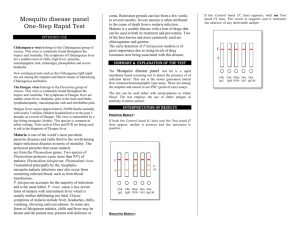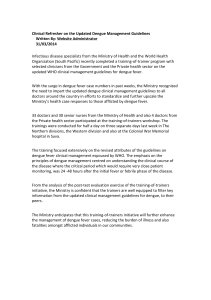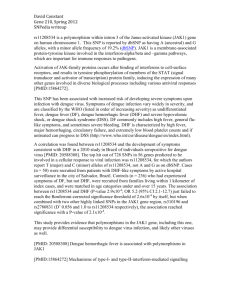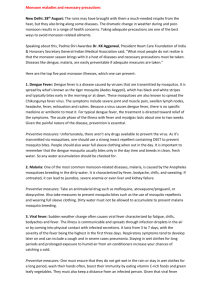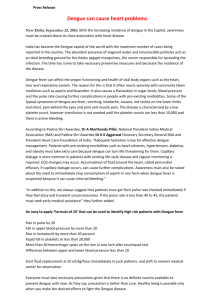Vector Control in Disaster Situations - PAHO (DOC)
advertisement
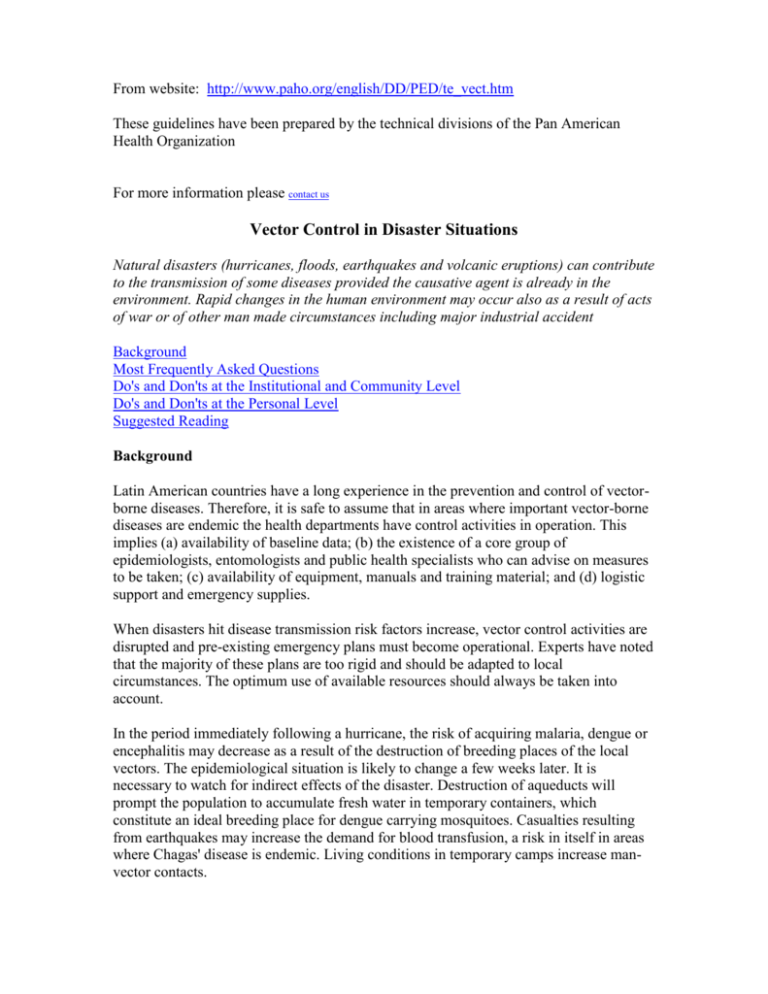
From website: http://www.paho.org/english/DD/PED/te_vect.htm These guidelines have been prepared by the technical divisions of the Pan American Health Organization For more information please contact us Vector Control in Disaster Situations Natural disasters (hurricanes, floods, earthquakes and volcanic eruptions) can contribute to the transmission of some diseases provided the causative agent is already in the environment. Rapid changes in the human environment may occur also as a result of acts of war or of other man made circumstances including major industrial accident Background Most Frequently Asked Questions Do's and Don'ts at the Institutional and Community Level Do's and Don'ts at the Personal Level Suggested Reading Background Latin American countries have a long experience in the prevention and control of vectorborne diseases. Therefore, it is safe to assume that in areas where important vector-borne diseases are endemic the health departments have control activities in operation. This implies (a) availability of baseline data; (b) the existence of a core group of epidemiologists, entomologists and public health specialists who can advise on measures to be taken; (c) availability of equipment, manuals and training material; and (d) logistic support and emergency supplies. When disasters hit disease transmission risk factors increase, vector control activities are disrupted and pre-existing emergency plans must become operational. Experts have noted that the majority of these plans are too rigid and should be adapted to local circumstances. The optimum use of available resources should always be taken into account. In the period immediately following a hurricane, the risk of acquiring malaria, dengue or encephalitis may decrease as a result of the destruction of breeding places of the local vectors. The epidemiological situation is likely to change a few weeks later. It is necessary to watch for indirect effects of the disaster. Destruction of aqueducts will prompt the population to accumulate fresh water in temporary containers, which constitute an ideal breeding place for dengue carrying mosquitoes. Casualties resulting from earthquakes may increase the demand for blood transfusion, a risk in itself in areas where Chagas' disease is endemic. Living conditions in temporary camps increase manvector contacts. The density of mosquitoes considered non-vectors of disease are likely to increase shortly after a hurricane hits. Even though these mosquitoes have no medical importance, the affected population demands and should get attention to the nuisance problem. No major communicable disease problems are normally expected in North America as a result of a disaster situation. In Mainland Middle America, the Caribbean, and Tropical South America existing arthropod-borne diseases include malaria, mucocutaneous leishmaniasis, diffuse cutaneous leishmaniasis, visceral leishmaniasis, onchocerciasis (river blindness), American trypanosomiasis or Chagas' disease, bancroftian filariasis, dengue fever, dengue hemorrhagic fever (DHF), Venezuelan equine encephalitis, viral encephalitis, human fasciolosis, tularemia, jungle yellow fever, bartonellosis, Oroya fever, louse-borne typhus, and plague. With the exception of Chagas'disease, the arthropod-borne diseases are not important in the countries of Temperate South America. In the context of a natural disaster, the most important vector-borne diseases in the Americas are malaria, dengue fever and dengue hemorrhagic fever. Urban yellow fever shares the vector of dengue, but yellow fever is rarely transmitted in urban areas except during an epidemic. Besides, yellow fever is preventable by a safe and effective vaccine. No vaccine is currently available for malaria, dengue fever or DHF. Frequently Asked Questions Q. Is it advisable to intervene based on the first news of the disaster received from the affected area? A. No. The information may be exaggerated, misguided or unsubstantiated. Q. Is it necessary to start vector control operations immediately following a disaster? A. No. Usually there is time to evaluate the situation and plan the necessary operations. Q. How do you define the affected area? A. The operational area should include the area directly affected by the disaster and the area receiving displaced population. Q. Are new diseases likely to appear during a disaster? A. No. A disaster can contribute to the transmission of some diseases provided the causative agent is already in the environment. Q. Is there a single, multipurpose, measure for the control of vector borne diseases? A. No. Control measures have to be targeted to specific vectors of diseases. Some measures, however, have more than one beneficial effect. Q. Is the increase in vector-breeding places the main cause of epidemics? A. No. The increased man-vector contact in precarious shelters and temporary camps and the disruption of control activities may be more important causes for epidemics. Q. Are epidemics after natural disasters predictable? A. Yes. Epidemics occurring after cyclical disasters such as hurricanes can be predicted within a reasonable degree of precision and should be preventable if the health services are adequately prepared. Q. Are there recent changes in the epidemiology of malaria? A. Yes. Malaria is re-emerging in many areas. Besides, the global warming may have been an important contributing factor in the occurrence of local epidemics in highland areas. Q. Are there PAHO/WHO publications on emergency vector control after natural disasters? A. Yes. A list appears in the "suggested reading" annex. Q. Which are the main measures for the control of vector-borne diseases? A. Vaccination for the prevention of jungle yellow fever (YF); Sanitation, rodenticides and localized application of insecticides, for plague control; Housing improvement, selective use of insecticides, use of pyrethroid-impregnated fabrics (PIFs) as a complement to traditional measures for the control of Triatoma infestans vector of Chagas's disease; Protection of domestic water reservoirs, destruction of artificial water containers, selective application of larvicides or adulticides, for the control of A. aegypti mosquitoes, vectors of Dengue, DHF and urban YF; Case detection and treatment; selective use of residual insecticides; prophylaxis with chloroquine or mefloquine in areas with chloroquine resistant strains, for malaria. Health education, community participation, modification of personal habits, repellents or barriers to diminish man-vector contact, in support of all of the above. The Do's at the institutional and community levels Establish preparedness plans for the control of epidemics of dengue, malaria and other vector borne diseases within the general organization of emergency health services, which in turn should be included within the National Disaster Preparedness Plans in areas at recognized risk; Update the epidemiological profiles of areas considered to be at risk, particularly when a potential disaster situation is forecasted; Arrange to have ready a core group of trained personnel, supplies and equipment as well as logistic support to strengthen prevention and control activities at short notice; Evaluate the situation and adjust the emergency plans to the local conditions before putting them into action. Epidemics of malaria, dengue and encephalitis subsequent to a disaster, if they occur at all, start about six weeks after the disaster hits. Make maximum use of epidemiological data directly related to disease management, especially at district and local levels. For instance, in relation to malaria, analyze data related to "fever treated with antimalarial drugs" and not only the positive smear rates. The Do's at the personal level Participate in community action groups for the control of larval habitats of A. aegypti in areas at risk of dengue or DHF ; Apply mosquito source reduction techniques in the home environment following the instructions of anti A. aegypti program personnel; Seek diagnosis and treatment for fever symptoms at the nearest health unit or community voluntary health worker post; Facilitate the application of residual insecticides when so indicated for the control of malaria epidemics; Use mosquito repellents when working outside the home during the evening hours and a mosquito net when sleeping. Note: Use of trade names is for identification only and does not imply endorsement by the Pan American Health Organization (PAHO/WHO) Suggested reading Vectir control after natural disasters. Pan American Health Organization, 1982. Scientific Publication No.419 Dengue y dengue hemorrágico en las Américas: guías para su prevención y control. Organización Panamaricana de la Salud, 1995 Pubicación científica No. 548 (Available in English, 1994) Implementation of the Global Malaria Control Strategy, WHO Technical Report Series, 839 World Health Organization, Geneva 1993 Malaria Epidemics: Detection and Control, Forecasting and Prevention. JA Nájera, RL Kouznetzsov and C Delacollette WHO/MAL/98.1084 (Orig. English). WHO Geneva, 1998 A new tactic for Triatoma infestans control: fabrics impregnated with betacypermethrin. Edgardo Wood, et. al.- Pan American Journal of Public Health, Vol. 6 No. 1 (July 1999) pp 1-7 PAHO/WHO, Washington, 1999 Centers for Disease Control and Prevention. Health Information for International Travel, 1999-2000, DHHS, Atlanta, GA Communicable Diseases. Text extracted from Health Conditions in the Americas, 1990 edition, Vol. I Scientific Publication No. 524 PAHO/WHO, Washington, DC 1990 Regional Overview of Malaria Control in the Americas "Roll Back Malaria in the Americas." PAHO/HCP/HCT/127/98-99, PAHO/WHO, 1998 Contact Otavio Oliva Phone: (202) 974-3707 Email: olivaot@paho.org

